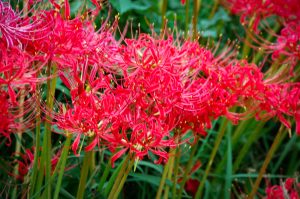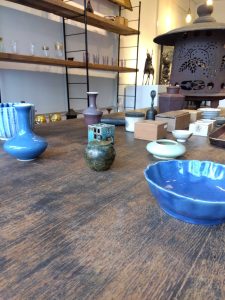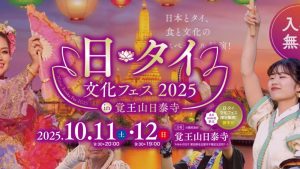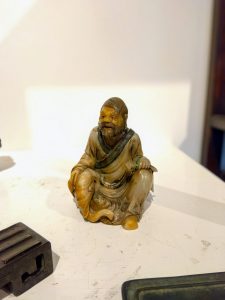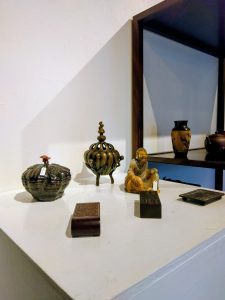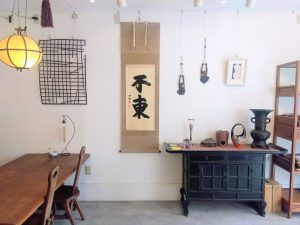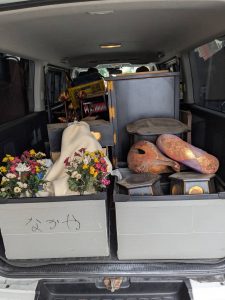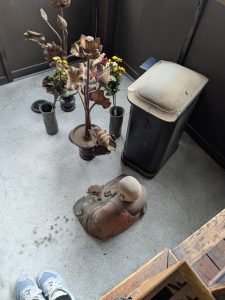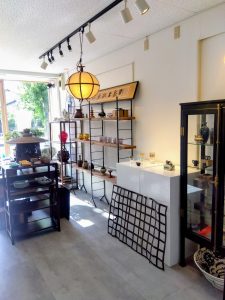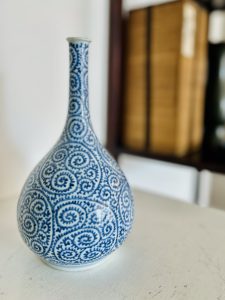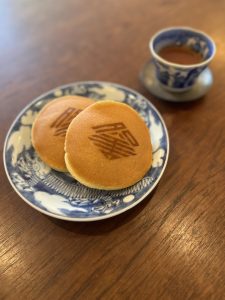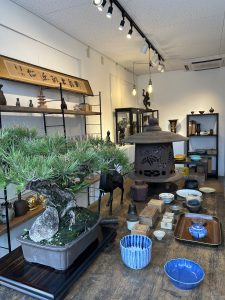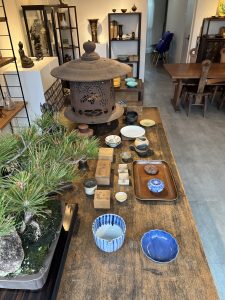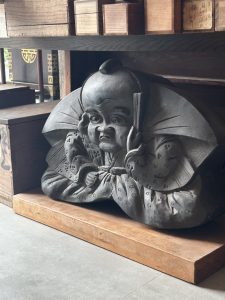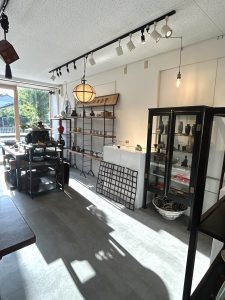一日だけ咲く芙蓉の花に引き寄せられました(愛知県名古屋市千種区姫池通 骨董買取 古美術風光舎)
2025.09.27
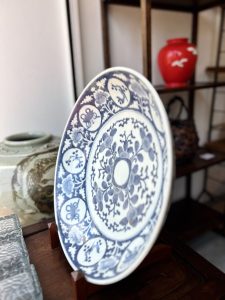
本日はまだ日傘が手離せないほどの強い日差しですが、どんぐりが道に落ちていたり、木に柿が実っていたりするので感覚がバグってしまいます。昨日のブログ写真のような彼岸花も咲き始めるなか、真夏に大輪の花を咲かせていた芙蓉が未だ艶やかに咲いていました。歩いているとちょうど目の高さに直径10cmから15cmほどの大きな真っ白い花が咲いているので、ぼんやり歩いている私の目にも飛び込んできます。芙蓉が咲く時期は7月下旬から10月初めにかけてということなので、そろそろ見納めかもしれません。
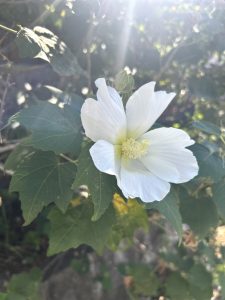
中国では芙蓉は富貴を象徴する花といわれ、美しい女性を形容する言葉としても使われてきました。咲く直前のつぼみも大きくふっくらとしていて、つぼみですら絵になります。
こんなにも華やかな花ですが、朝に咲き、夕方には萎み枯れてしまう「一日花(いちにちばな)」なのだそうです。一日だけなんてもったいないと思ってしまうのは私だけでしょうか。
芙蓉の中には「酔芙蓉」と呼ばれる種類があり、朝に咲く白い花が昼頃には薄いピンク、夕方には濃いピンクに変化するため、花が酔っているように見えることから名付けられました。切り花でも色が変化するようなので、ぜひ変化の様子をじっくりと見てみたいものです。色の変化はアントシアニンの合成によるもので、午後以降にアントシアニンが花弁にたまり赤く染まっていくのだとか。特に温度差が25度以上だと色の変化が顕著になるとのこと。
どなたかが「植物は考える生きもの」だと仰っていましたが、動くことができない分、様々な戦略を練って子孫を残そうとします。受粉を助けてくれる蜂は視力が良くないが白い花はよく見えるそうで、朝の白い花は、咲き始めで蜜がたくさんあることを蜂にアピールしているのだとか。そういえば今日も大きな蜂が白い芙蓉の花の周りをブンブン飛んでおり、怖くてゆっくり写真が撮れませんでした。芙蓉と蜂からしてみれば、明らかに私の方が邪魔者なのですが…。白い花びらは時間と共に赤く変化し、受粉済みの赤い花にはあまり蜜が残っていないことを蜂に学習させ、効率的に白い花におびき寄せるのだそうです。植物って本当に賢い生き物ですね。
一日花には水色の小さな花を一面に咲かせる「オオイヌノフグリ」や南国の「ハイビスカス」などがあり、午前中だけ咲く「あさがお」や「ツユクサ」など短命な花はたくさんあります。賢い植物のことですので一日しか花を咲かせないのにも何か理由があるのではと思い少し調べてみました。
一日だけ咲く理由には諸説あるようですが、一つには種子を作る際に遺伝子の近いもの同士の「自家受粉」を避けるためというのがあります。進化のためにもなるべく他の遺伝子を取り込もうとしているのではとのこと。また一日花は高温多湿な環境を好む傾向にあるため、長く咲くという負担を避け、効率的にたくさんの種子を作るために短命となり、次々と花を咲かせているとも考えられています。植物の世界は奥深いです。
美しい芙蓉の花が1日だけの命なんてもったいないとも思ってしまいますが、たった1日、美しく凛と咲くというのもありなのでは!などと人間の勝手な妄想を膨らませております。
それでは、また次の機会に。(スタッフH)
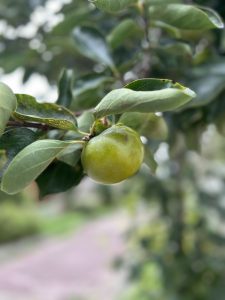
Today’s sunlight is still so strong I can’t part with my parasol, yet acorns litter the path and persimmons hang heavy on the trees—it feels like my senses are glitching. While red spider lilies like the ones in yesterday’s blog photo are starting to bloom, the hibiscus that burst into large flowers during midsummer still blooms vibrantly. As I walk, these large, pure white flowers, about 10 to 15 cm in diameter, bloom right at eye level, catching my gaze even when I’m walking absentmindedly. Since hibiscus typically bloom from late July to early October, this might be my last chance to see them.
In China, the hibiscus is said to symbolize wealth and nobility, and it was also used as a term to describe beautiful women. Even the buds just before blooming are astonishingly large and plump, making them picturesque even in their unopened state.
Despite being such a splendid flower, it’s actually a “one-day flower” that blooms in the morning and wilts and dies by evening. Am I the only one who thinks it’s such a waste that they only last a single day?
Among the hibiscus varieties is one called the “Drunken Hibiscus.” It’s named because its white flowers in the morning change to pale pink around noon and deep pink by evening, making the flowers appear as if they’re drunk. Apparently, the color changes even in cut flowers, so I’d love to observe this transformation closely. This color change is caused by the synthesis of anthocyanin. Apparently, anthocyanin accumulates in the petals after noon, gradually staining them red. The color change is especially pronounced when the temperature difference exceeds 25 degrees Celsius.
Someone once said, “Plants are thinking beings.” Unable to move, they devise various strategies to ensure their offspring survive. Bees, which aid in pollination, have poor eyesight but can see white flowers well. The white morning bloom apparently signals to bees that it’s just opening and rich in nectar. Come to think of it, today a large bee was buzzing around a white hibiscus flower, and I was too scared to take a proper photo… From the hibiscus and the bee’s perspective, I was clearly the intruder… The white petals gradually turn red over time, teaching the bees that red, pollinated flowers have little nectar left, efficiently luring them to the white ones. Plants really are clever creatures.
Among one-day flowers are the “common speedwell” with its blanket of tiny blue blossoms and the tropical “hibiscus.” There are also many short-lived flowers like the morning glory and the common chickweed that bloom only in the morning. Since plants are so clever, I wondered if there might be a reason they bloom for just one day, so I did a little research.
There seem to be several theories about why they bloom for just one day. One is to avoid “self-pollination” between genetically similar individuals when producing seeds. It’s thought they try to incorporate other genes as much as possible for evolutionary purposes. Also, since dayflowers tend to prefer hot, humid environments, it’s believed they become short-lived to avoid the burden of blooming for long periods, efficiently producing many seeds by continuously flowering one after another. The plant world is profound.
I used to think it was such a waste that the beautiful hibiscus flower only lives for a day, but then I started letting my imagination run wild—maybe blooming beautifully and proudly for just one day is perfectly fine too!
Well then, until next time. (Staff H)
*******************
ご実家の整理やお片付けなどをされている方のご相談などが多くございます。
お片付けなどくれぐれもご無理のないようになさってくださいませ。
風光舎では古美術品や骨董品の他にも絵画や宝石、趣味のお品など様々なジャンルのものを買受しております。
お片付けをされていて、こういうものでもいいのかしらと迷われているものでも、どうぞお気軽にご相談下さいませ。
また風光舎は、出張買取も強化しております。ご近所はもちろん、愛知県内、岐阜県、三重県その他の県へも出張いたします。
まずは、お電話お待ちしております。
愛知県名古屋市千種区姫池通
骨董 買取【古美術 風光舎 名古屋店】
TEL052(734)8444
10:00-17:00 OPEN
#出張買取#骨董#古美術#骨董品#絵画#版画#茶道具#刀剣#彫刻

